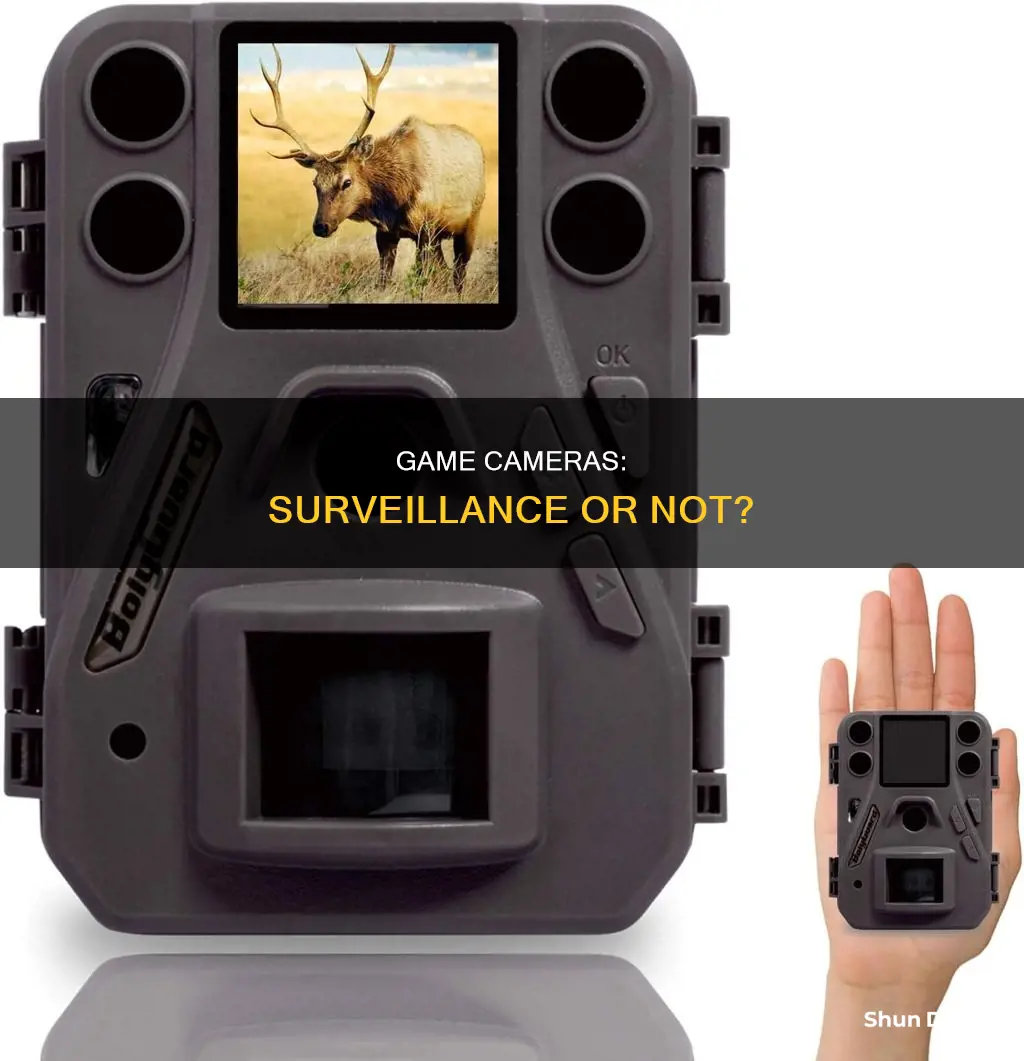
Game cameras, also known as trail cameras, are often used by hunters and sports photographers to capture images of wildlife. However, they can also be used for home security surveillance. Game cameras are typically motion-activated and can be placed almost anywhere, making them a good choice for monitoring outdoor areas that are beyond the range of traditional surveillance cameras. They are also durable, discreet, and capable of capturing images and videos in low-light conditions. While game cameras offer an additional layer of security, they also have limitations, such as shorter battery life and lack of pan/tilt functionality. For dedicated home security, professional surveillance cameras with advanced features like pan/tilt/zoom and Power over Ethernet (PoE) are more suitable.
| Characteristics | Values |
|---|---|
| Purpose | Wildlife tracking vs security and surveillance |
| Image quality | Higher resolution means clearer images |
| Detection range | 20-120 feet |
| Local storage | SD card support |
| Remote access | 4G/Wi-Fi connectivity |
| Power source | Battery-powered |
| Installation | Wired vs wireless |
| Features | Motion detection, night vision, time-lapse mode, etc. |
What You'll Learn

Trail cameras can be used for home security
Trail cameras, also known as game cameras, are a great choice for supplementing dedicated home security cameras. They are an effective way to monitor your property and can be used both indoors and outdoors.
Features of Trail Cameras
Trail cameras are remote digital cameras that capture images and videos of wildlife. They are equipped with motion sensors that detect when an animal enters a selected area, triggering the camera to take photos or videos. Some models also have time stamps, allowing you to know when the game is active in the area. Additionally, certain trail cameras can send pictures and videos to your smartphone in real time.
Advantages of Trail Cameras for Home Security
Trail cameras are an excellent addition to your home security system due to their versatility and durability. Here are some benefits:
- Durability and Weather Resistance: Trail cameras are designed to withstand tough weather conditions, making them suitable for mounting in harsh outdoor environments.
- Remote Monitoring: Trail cameras can be placed in remote areas without power outlets since they are battery-operated. This allows you to monitor areas beyond your home's Wi-Fi range or blocked by obstacles like trees.
- Infrared Flash: Trail cameras often have an infrared flash feature, allowing them to capture photos and videos discreetly in low light or no light conditions without alerting intruders.
- High-Definition (HD) Capabilities: Opting for a trail camera with HD capabilities, especially night vision, ensures clear and detailed images, aiding in identifying potential intruders.
- Audio and Video: While some trail cameras only capture video, others offer audio as well. Audio can be beneficial for security purposes, allowing you to hear voices, barks, or other distinctive sounds.
- Discreet Surveillance: Trail cameras are designed to be camouflaged, making them ideal for discreet surveillance. They can be hidden in various locations, such as trees, bushes, or birdhouses, without being easily spotted by intruders.
- License Plate Capture: Certain trail cameras are optimized to capture license plate numbers of moving vehicles in low-light conditions, which can be useful for security and evidence collection.
Tips for Using Trail Cameras for Home Security
When using trail cameras for home security, consider the following tips:
- Placement: Strategically place the trail camera out of sight, ensuring it is within range and well-camouflaged. Consider mounting it on trees, roofs, or telephone poles, or hiding it in bushes, birdhouses, or decorative items.
- Resolution: Choose a trail camera with a resolution of at least 720p or 8 MP to ensure clear and detailed images for effective security monitoring.
- Detection Range: Opt for a trail camera with a wide detection range, especially if you have a large property. This will enable the camera to capture clearer images of potential intruders.
- Battery Life: Look for trail cameras with long battery life and power-saving modes to ensure continuous operation without frequent battery replacements.
- Remote Access: Select a trail camera with cellular or Wi-Fi connectivity to remotely access and download videos and photos to your devices.
Limitations of Trail Cameras for Home Security
While trail cameras offer significant benefits for home security, they also have some limitations:
- Indoor Aesthetics: Trail cameras are typically designed for outdoor use and may not aesthetically match indoor decor due to their army-like camouflage colours.
- Limited Field of View: Trail cameras have fixed lenses and lack pan/tilt functionality, which may result in missing certain details in the surrounding background.
- Battery Drain with Video Recording: AA batteries in trail cameras may not last long when recording videos, requiring regular replacements or the use of backup batteries.
- Limited App Functionality: The mobile and desktop apps associated with trail cameras may offer fewer features compared to professional security camera apps.
In conclusion, trail cameras can indeed be used for home security, providing an extra layer of protection. They are versatile, durable, and well-suited for outdoor surveillance. However, for comprehensive indoor and outdoor security, it is advisable to consider a combination of trail cameras and professional security cameras, each serving their specific purposes.
Japan Camera Import: Customs and Charging
You may want to see also

They can be used to monitor indoor and outdoor spaces
Game cameras, also known as trail cameras, can be used to monitor both indoor and outdoor spaces. They are equipped with motion sensors that detect movement and capture images or videos, making them suitable for security surveillance. Here are some ways in which game cameras can be utilised for monitoring different areas:
Outdoor Surveillance
Game cameras are often used outdoors for hunting and wildlife monitoring. They can be mounted on trees or other structures to capture images of wildlife. This feature can also be advantageous for outdoor security. The motion sensors in game cameras can detect any movement within the monitored area, capturing photos or videos that can be used for security purposes. This is particularly useful for monitoring areas beyond the range of traditional surveillance cameras, such as yards, driveways, or the perimeter of a property.
Indoor Surveillance
While game cameras are commonly associated with outdoor use, they can also be effective for indoor surveillance. Their small size and battery-powered operation make them easy to place in various locations without being restricted by power outlets. This flexibility allows for discreet placement, ensuring that the camera blends in with its surroundings and goes unnoticed. Game cameras can be positioned in corners, on shelves, or even camouflaged among indoor plants to monitor indoor spaces effectively.
Advantages of Game Cameras for Surveillance
Game cameras offer several benefits that make them a valuable addition to a security system:
- Durability: Game cameras are designed to withstand outdoor conditions, including tough weather, making them durable and suitable for harsh environments.
- Discreet Surveillance: Some game cameras are equipped with infrared flash or low-glow/no-glow features, allowing them to capture images without a visible flash. This makes them ideal for covert surveillance as they can remain inconspicuous and not alert potential intruders.
- Remote Access: Many modern game cameras offer remote access capabilities. They can be connected to a cellular network or Wi-Fi, allowing users to remotely access footage and receive real-time alerts on their smartphones or computers.
- Flexibility: Game cameras can be easily moved and repositioned, providing flexibility in monitoring different areas as needed.
- Cost-effectiveness: Game cameras can be a more affordable option compared to professional security cameras, providing an economical way to enhance security without incurring high equipment costs.
The Evolution of Folding Cameras: A Historical Perspective
You may want to see also

Trail cameras are triggered by motion and heat sensors
Trail cameras, also known as game cameras, are often used by hunters and wildlife photographers. They are triggered by motion and heat sensors, which detect relative temperature changes and moving objects. This technology was initially designed to film animals in the wild, but it is also effective for security footage.
The motion sensors in trail cameras are activated by changes in the temperature in front of the camera. This technology is known as PIR (Passive Infrared) and is the same type of motion detection used in automatic doors. When the PIR sensor is triggered, the camera captures a photo, a burst of multiple photos, or a short video.
Trail cameras are useful for security purposes as they can be placed almost anywhere, even in remote areas without power outlets, thanks to their battery operation. They are also designed to withstand harsh weather conditions and are often equipped with night vision capabilities, making them ideal for outdoor security.
The versatility of trail cameras makes them a popular choice for monitoring wildlife, farm management, gardening, nature viewing, and home security. They are triggered by motion and heat sensors, allowing them to capture candid images of wildlife and potential intruders.
Charging GH5 Batteries: In-Camera Method
You may want to see also

They are battery-powered and easy to install
Game cameras, also known as trail cameras, are typically battery-powered. This means they can be placed almost anywhere, even in remote areas without power outlets. They are also easy to install, requiring no wires. This makes them highly flexible, and they can be placed indoors or outdoors, on a flat surface or mounted on a wall.
The batteries in game cameras can last for months, but it is important to monitor their charge levels and replace them when necessary. Some game cameras have rechargeable batteries, while others use disposable batteries. Rechargeable batteries are more cost-effective and environmentally friendly in the long run, but disposable batteries may be more convenient if you don't have access to a power source to recharge them.
When installing a game camera, it is important to consider the placement carefully. If you are using it for security purposes, you may want to hide it in a discreet location where people won't easily see it. Consider factors such as the detection range, angle, and surrounding environment when deciding where to place the camera.
In addition to battery power and ease of installation, game cameras have other features that make them suitable for home security or wildlife monitoring. They have motion sensors or heat sensors that detect movement or temperature changes, respectively. They also often have night vision capabilities, allowing them to capture clear footage even in low-light conditions.
Overall, the battery-powered and easy-to-install nature of game cameras makes them a versatile option for a variety of use cases, whether you're monitoring wildlife activity or enhancing your home security system.
Exploring Polaroid Camera Modes: Capturing Creative Shots
You may want to see also

Trail cameras are more affordable than professional security cameras
Trail cameras, also known as game cameras, are often used by hunters and wildlife photographers to monitor wildlife. However, they can also be used for home security surveillance. They are equipped with motion sensors and can capture images or videos when they detect movement, making them suitable for detecting suspicious activity near your property. One of their advantages is that they are battery-powered, so they can be placed almost anywhere, even in remote areas without power outlets. They are also relatively affordable, with some models offering high-definition video capabilities and night vision for under $200.
In contrast, professional security cameras are designed specifically for security and surveillance. They offer 24-hour live video feeds and have features such as pan/tilt/zoom functionality, Power over Ethernet (POE), and the ability to monitor multiple cameras simultaneously through a network video recorder (NVR) system. These cameras are usually more obvious and visible, serving as a deterrent to potential intruders.
While trail cameras may not have all the advanced features of professional security cameras, they are a more affordable option for those seeking to supplement their home security. They can be discreetly placed in outdoor areas and provide high-quality images and videos, making them a viable choice for those on a budget.
Overall, trail cameras offer a cost-effective solution for those who want to enhance their home security without incurring the higher costs associated with professional security camera systems.
Garry's Mod Camera Mode: A Step-by-Step Guide
You may want to see also
Frequently asked questions
Game cameras, also known as trail cameras, are remote digital cameras that capture images and videos of wildlife. They are often motion-triggered and can be used for hunting, wildlife monitoring, land management, and security surveillance.
Yes, game cameras can be used as an additional layer of security to monitor suspicious activity near your property. They offer remote access, night vision, and long battery life, making them suitable for outdoor security. However, they have limited functionality compared to professional security cameras and are not suitable for indoor use.
Game cameras are easy to set up, discreet, and can be placed almost anywhere, even in remote areas without power outlets. They are also relatively affordable and can provide timely alerts and evidence in the event of trespassing or vandalism.
Game cameras lack pan/tilt functionality due to their fixed lenses, which can result in missing important details in the surrounding background. They also have shorter battery life when recording videos and may require frequent replacements. Additionally, their mobile/desktop apps offer limited features compared to dedicated security camera applications.







